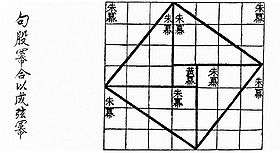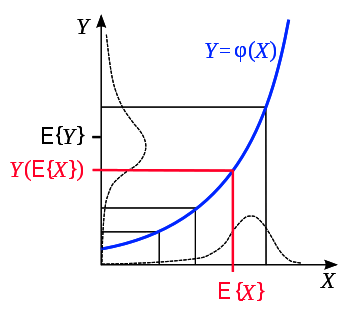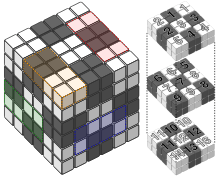Proof without words
In mathematics, a proof without words is a proof of an identity or mathematical statement which can be demonstrated as self-evident by a diagram without any accompanying explanatory text. Such proofs can be considered more elegant than formal or mathematically rigorous due to their self-evident nature.[1] When the diagram demonstrates a particular case of a general statement, to be a proof, it must be generalisable.[2]

Examples
Sum of odd numbers

The statement that the sum of all positive odd numbers up to 2n − 1 is a perfect square—more specifically, the perfect square n2—can be demonstrated by a proof without words, as shown on the right.[3] The first square is formed by 1 block; 1 is the first square. The next strip, made of white squares, shows how adding 3 more blocks makes another square: four. The next strip, made of black squares, shows how adding 5 more blocks makes the next square. This process can be continued indefinitely.
Pythagorean theorem

The Pythagorean theorem can be proven without words as shown in the second diagram on left. The two different methods for determining the area of the large square give the relation
between the sides. This proof is more subtle than the above, but still can be considered a proof without words.[4]
Jensen's inequality

Jensen's inequality can also be proven graphically, as illustrated on the third diagram. The dashed curve along the X axis is the hypothetical distribution of X, while the dashed curve along the Y axis is the corresponding distribution of Y values. Note that the convex mapping Y(X) increasingly "stretches" the distribution for increasing values of X.[5]
Usage

Mathematics Magazine and the College Mathematics Journal run a regular feature titled "Proof without words" containing, as the title suggests, proofs without words.[3] The Art of Problem Solving and USAMTS websites run Java applets illustrating proofs without words.[6][7]
See also
| Wikimedia Commons has media related to Proof without words. |
Notes
- Dunham 1994, p. 120
- Weisstein, Eric W. "Proof without Words". MathWorld. Retrieved on 2008-6-20
- Dunham 1994, p. 121
- Nelsen 1997, p. 3
- "Jensen's Inequality", Bulletin of the American Mathematical Society, American Mathematical Society, 43 (8), p. 527, 1937, doi:10.1090/S0002-9904-1937-06588-8
- Gallery of Proofs, Art of Problem Solving, retrieved 2015-05-28
- Gallery of Proofs, USA Mathematical Talent Search, retrieved 2015-05-28
References
- Dunham, William (1994), The Mathematical Universe, John Wiley and Sons, ISBN 0-471-53656-3
- Nelsen, Roger B. (1997), Proofs without Words: Exercises in Visual Thinking, Mathematical Association of America, p. 160, ISBN 978-0-88385-700-7
- Nelsen, Roger B. (2000), Proofs without Words II: More Exercises in Visual Thinking, Mathematical Association of America, pp. 142, ISBN 0-88385-721-9